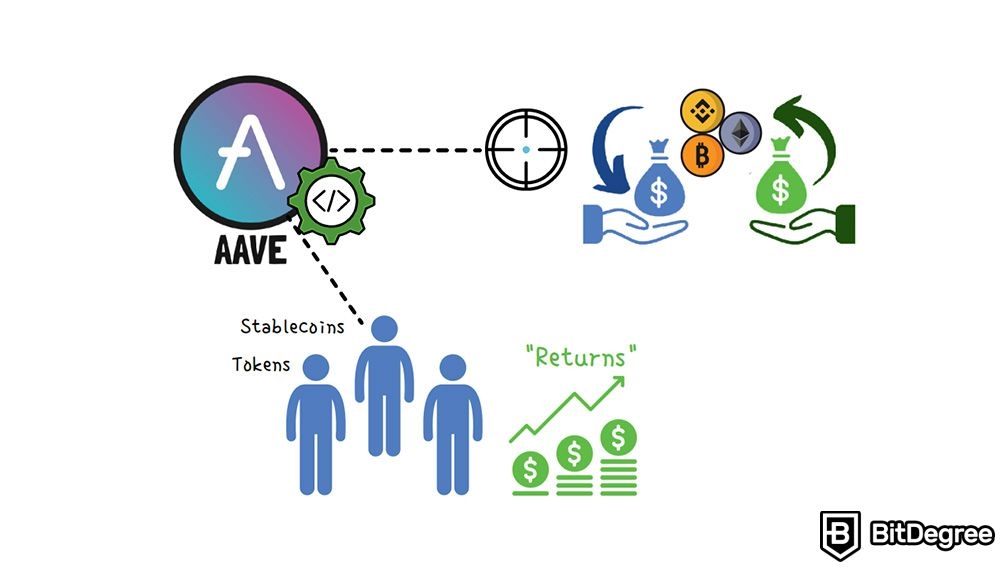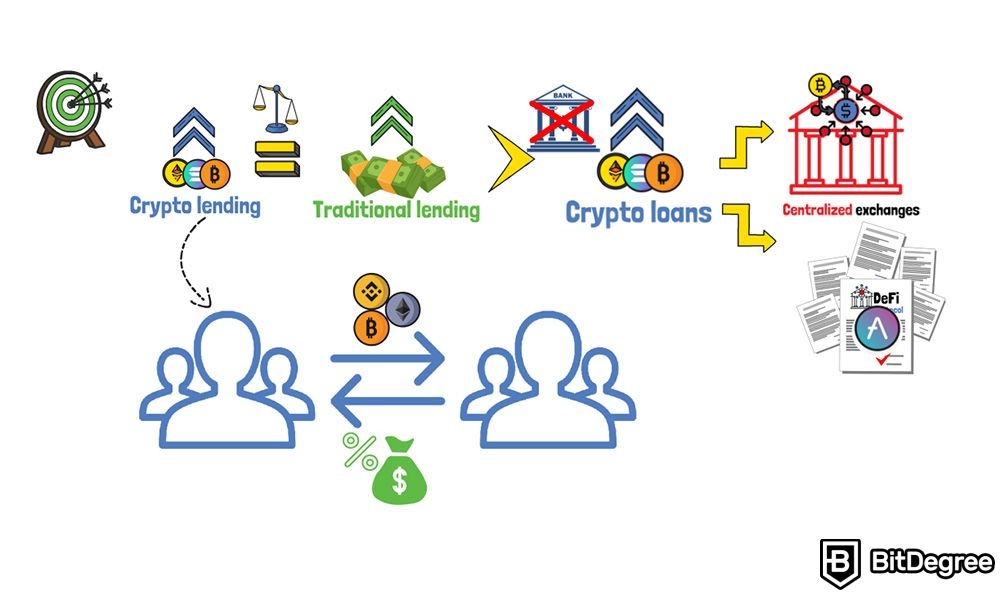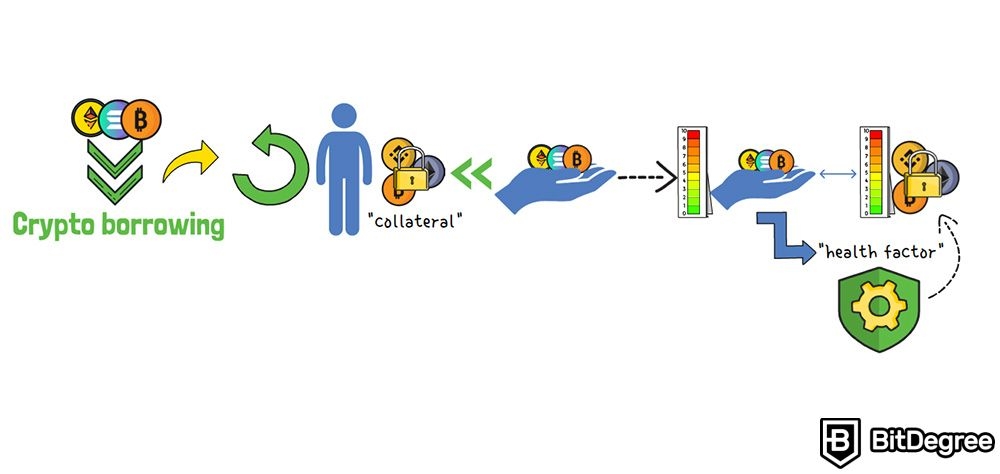2.15 Aave: Crypto Lending Trailblazer
Free Airdrop Season 7 is LIVE! Answer fun questions or do simple tasks to earn rewards from the $30K BitDegree prize pool. Participate Now ! 🔥
In this section, I’m going to answer the question of “What is Aave crypto?”, and take a look into how does Aave crypto work.
For newcomers, it’s a challenge to talk about the Aave meaning in crypto, when most don’t even know how to pronounce it! But such a minor obstacle should not keep us from learning about how to use Aave crypto, since for those who know, it’s a treasure chest full of new DeFi opportunities and open possibilities.
But, once again, Aave may appear confusing for crypto beginners, simply because it’s not merely a cryptocurrency or a blockchain network. It’s a DeFi protocol that functions as a decentralized crypto lending platform that lets users borrow and lend crypto. And, naturally, understanding this requires having quite a solid base of the crypto fundamentals. Nevertheless, if you’re looking to get Aave explained, you’ve come to the right place!
In this section, we’re going to delve into questions that range from “What is Aave crypto?” to “How to use Aave crypto,” and cover everything in between.
Without wasting any time, let’s jump right into it!
What is Aave Crypto?
So, let’s begin by laying out the foundations. The core question is, naturally - what is Aave crypto?
In dry theory, Aave presents itself as a “decentralized non-custodial liquidity market protocol where users can participate as suppliers or borrowers.” The attractive part about becoming a supplier is the fact that it allows users to earn a passive income. But, such an explanation is overly technical, and half of the words used here need explainer sections of their own! Therefore, let’s get a bit more down to earth.

In Finnish, “Aave” means “ghost.” Introduced back in 2017, it’s a groundbreaking DeFi protocol that operates on the Ethereum blockchain. What makes Aave so special is the fact that it transformed the landscape of lending and borrowing in the crypto industry. There was a gap in the market, an opportunity for a promising project to enter the crypto space and offer something new, when it comes to this kind of cryptocurrency-related activities. Aave did just that.
Aave’s core principles are rooted in decentralization, transparency, and accessibility. Through smart contracts, Aave allows users to lend and borrow cryptocurrencies seamlessly, without relying on traditional financial institutions, such as banks. And, even though today that doesn’t sound so revolutionary, this was a game-changing service back then. As of writing, the Aave system enables users to lend or borrow 17 different cryptocurrencies.
Aave protocol's unique features and user-centric approach have made it a prominent player in the DeFi space, driving the adoption of decentralized financial services. Aave was created with a very clear mission – to allow users to lend and borrow different cryptocurrencies and tokens. For example, users can supply assets like stablecoins or tokens, and, eventually, see returns from this investment.

These returns vary depending on the asset, blockchain, supply and demand, and the version of Aave that’s being used. As of August 2023, there are three versions: Aave v1, v2, and v3, each with its own upgrades!
Though, crypto lending and borrowing discussions require that the viewer feels confident about such concepts as smart contracts. Therefore, if you feel like your knowledge needs some refreshing, check this section, where I cover this topic in more detail!
Okay, so that was a very brief introduction about what makes Aave more than just yet another cryptocurrency. But, as you might have already noticed, when it comes to understanding how does Aave crypto work, the learning curve is pretty steep. So, let’s begin by dissecting the daunting-looking, yet essential crypto concepts that constitute the Aave project.
What is Crypto Lending & Borrowing?
It’s impossible to answer the question of “What is Aave crypto?” without addressing a more fundamental question of “What is crypto lending?” So, let’s have a quick rundown of the concept.

Ever since crypto lending came around in 2020, it has revolutionized the world of DeFi, unlocking new possibilities for both lenders and borrowers. With crypto lending, individuals can now generate passive income while borrowers can access instant cash without facing tax-related unpleasant experiences.
At its core, crypto lending functions similarly to traditional lending, with one party lending cryptocurrency to another in exchange for interest payments. However, there are significant differences that make it stand out.
Unlike traditional banks, crypto loans are facilitated through centralized exchanges or decentralized finance protocols such as AAVE. As you can see, Aave is a reference point when it comes to this crucial DeFi aspect.
What makes crypto lending special is the absence of formal intermediaries that are usually seen as unavoidable with such institutions as banks. Instead, crypto lending relies on smart contracts that automate the entire process, including repayment terms and costs agreed upon in advance. Moreover, crypto lending doesn't require registration with any regulatory authority, offering a borderless lending experience through Web3 wallets.

Think of it as buying a can of coke from a vending machine, which allows you to skip any interactions with cashiers, or waiting in grocery store lines!
Now, to lend assets on Aave, users need to select the network and version of the Aave that they’re using, as well as choose the asset they want to supply. After confirming the transaction in their in-browser wallet, users can provide the desired amount of the asset.
Borrowing assets follows a similar process but in reverse. Users must supply assets as collateral before being able to borrow. The maximum amount you can borrow depends on the amount you deposit and the "health factor," which represents the safety of your collateral. It's important to keep the health factor above 1 to ensure the safety of your deposit.
But this covers only the surface of what’s possible with Aave. Therefore, let’s dive deeper into what exactly has Aave offered to the crypto lending & borrowing industry.
What Makes Aave Different?
One way to establish your name within the industry is to offer something new. And, introducing several key innovations that have changed the industry, was exactly what Aave did.
First of all, flash loans must be mentioned. Aave popularized the concept of flash loans, which allow users to borrow assets without requiring collateral, as long as the borrowed amount is returned within the same Ethereum transaction.
Flash loans have revolutionized the DeFi ecosystem by enabling arbitrage opportunities and complex financial strategies, expanding the possibilities for developers and traders.
Sounds complicated? Don’t worry, there's a separate section covering crypto arbitrage in this Crypto 101 Handbook, so be sure to check it out!
Okay, back to answering “What is Aave crypto and what makes Aave so special?" As mentioned before, flash loans differ from usual crypto loans because they allow users to borrow crypto without providing collateral. But it’s not that easy. Not anyone can take out a flash loan.

Flash loans serve as a specialized feature tailored towards developers, leveraging their technical expertise to execute such transactions. With flash loans, individuals have the ability to borrow assets without the need for collateral, provided the liquidity is promptly returned to the protocol within a single block transaction. This requires technical knowledge, which makes the answer to “How to use Aave crypto?” not that simple!
To receive a flash loan, a well-crafted contract is required. This contract acts as the gateway for requesting a flash loan, initiating the series of steps outlined within its code. The crucial aspect lies in the seamless execution of these instructed steps, ensuring that the loan amount, along with the accrued interest and fees, is repaid, all within the confines of a single transaction.
Up next, we’ve got the fact that Aave offered a novel approach to interest rates. In fact, Aave introduced a new interest rate model called "interest rate swaps." This model allows users to choose between stable or variable interest rates for their borrowing positions. Users can switch between different interest rate types based on market conditions and their risk appetite, providing flexibility and control over their borrowing costs.
Such a flexible approach immediately put Aave on the front lines of the crypto borrowing game, since this meant more freedom and individually-tailored opportunities for different DeFi investors. And that’s a strong advantage, taking into account how different most of the DeFi investors and their financial positions are.
Among other novelties, Aave made its name by introducing “undercollateralized loans”, which are also known as credit delegation. This feature allows users to delegate their borrowing power to trusted individuals or institutions, who can then borrow assets without providing the full collateral themselves. It enables creditworthiness assessment and the utilization of credit lines in a decentralized manner, expanding access to borrowing opportunities.
One way to think of it is like lending to a trusted friend or a family member. You know their behavior, whether they could be trusted, and if it makes sense to expect them to pay you back what they owe. If it’s a trusted individual, you’ll be able to lend them some money without collateral. Their reputation speaks for itself.

Moving further, there’s also “market-based collateralization.” Aave introduced this concept, where users can deposit their assets into the protocol and receive something known as aTokens in return. These aTokens represent the value of the deposited assets and accrue interest in real-time. Enthusiasts can use aTokens as collateral to borrow other assets, allowing them to leverage their existing holdings without needing to sell them.
What’s interesting about aTokens is that their value is pegged to the value of the corresponding deposited asset at a 1:1 ratio. Such a feature allows them to be safely stored, transferred or traded, thus creating more opportunities for the Aave ecosystem to grow and develop. All interest collected by the aTokens is distributed to their holders by continuously increasing their wallet balance.
And finally, something that must be mentioned is the fact that Aave has implemented a governance system that allows Aave token holders to propose and vote on protocol upgrades, improvements, and risk management parameters. Additionally, Aave introduced a Safety Module, where users can deposit Aave tokens to act as insurance against possible protocol risks. This safety mechanism protects the protocol and users from potential losses.
Wrapping Up
So, I’ve taken a look into the overall Aave meaning in crypto, what makes this project so special, and what kind of services does Aave provide. Therefore, now, I'm sure you'll know the answer to the question of “What is Aave crypto?”
As you have probably noticed, Aave is definitely not the most convenient starting point for those who are new in the crypto space. Nevertheless, understanding crypto lending and borrowing is not only key to understanding Aave, but DeFi, as a whole, and being able to see how many hidden layers or opportunities await those who are eager enough to keep on learning and growing.









